
Liverpool is a city and metropolitan borough in Merseyside, northwest England. It had a population of 496,770 in 2022. The city is located on the eastern side of the Mersey Estuary, adjacent to the Irish Sea, and is approximately 178 miles (286 km) from London. Liverpool is the fifth largest city in the United Kingdom, the largest settlement in Merseyside and part of the Liverpool City Region, a combined authority with a population of over 1.5 million.
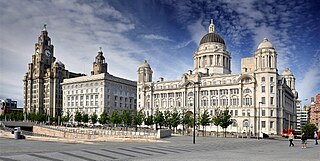
Merseyside is a ceremonial and metropolitan county in North West England. It borders Lancashire to the north, Greater Manchester to the east, Cheshire to the south, the Welsh county of Flintshire across the Dee Estuary to the southwest, and the Irish Sea to the west. The largest settlement is the city of Liverpool.
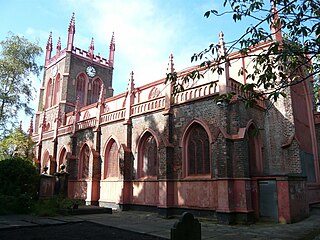
St Michael's Hamlet, also known as St Michael-in-the-Hamlet or simply St Michael's, is a suburb of Liverpool, Merseyside, England and a Liverpool City Council Ward. It is located to the south of the city, bordered by Dingle, Aigburth and Mossley Hill.

Toxteth is an inner-city area of Liverpool in the county of Merseyside.

Old Swan is an eastern neighbourhood of Liverpool, Merseyside, England, bordered by Knotty Ash, Stoneycroft, Broadgreen, Fairfield and Wavertree. At the 2011 Census, the population was 16,461.

Hope Street in Liverpool, England, stretches from the city's Roman Catholic cathedral, past the Anglican cathedral to Upper Parliament Street and it is the local high street of the Canning Georgian Quarter. It contains various restaurants, hotels and bars and is one of Liverpool's official 'Great Streets' and was also awarded 'The Great Street Award' in the 2012 Urbanism Awards, judging it to be the best street in the country. The road runs parallel to Rodney Street. Together with Gambier Terrace and Rodney Street it forms the Rodney Street conservation area.

Byker is a district in the east of the city and metropolitan borough of Newcastle upon Tyne, in the county of Tyne and Wear, England. Home to the Byker Wall estate, made famous by TV series Byker Grove, Byker's population was recorded at 12,206 in the 2011 census. Byker is bordered by Heaton to the north and by Shieldfield to the north east. Until 1974 it was in Northumberland.

Kirkdale is a district of Liverpool, Merseyside, England, and a Liverpool City Council ward that covers both Kirkdale and Vauxhall. At the 2011 Census, the population was 16,115.

Fairfield is an area of Liverpool, in Merseyside, England, encompassing streets between Tuebrook and Kensington and stretching to Old Swan. It consists of a variety of houses; there are some traditional red-brick terraces, larger Victorian villas and also the notable 300-year-old Georgian Fairfield Crescent which is off the equally old Prospect Vale. The area also contains the Victorian Newsham Park; Friends of Newsham Park meet with council officers regularly at the Newsham Park park forum to discuss improvements to the park and are currently anticipating the start on site of the building of a new pavilion.
'Stop the Rot' is a campaign launched in October 2000 by the Liverpool Echo newspaper with the aim of rescuing and preserving the rich architectural heritage of Liverpool and the greater Merseyside area. The campaign was launched when part of the Casartelli Building in Hanover Street in Liverpool collapsed, and this building subsequently became the symbol of the campaign.
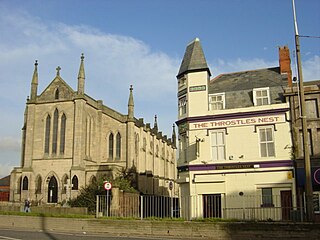
Vauxhall is an inner city district of Liverpool, England, north of the city centre, bounded by Kirkdale to the north and Everton to the east, with the docks and River Mersey running along the west side.

The architecture of Liverpool is rooted in the city's development into a major port of the British Empire. It encompasses a variety of architectural styles of the past 300 years, while next to nothing remains of its medieval structures which would have dated back as far as the 13th century. Erected 1716–18, Bluecoat Chambers is supposed to be the oldest surviving building in central Liverpool.

The Baltic Triangle is an area of Liverpool city centre defined by Liverpool City Council as the triangular portion of the city bounded by Liver Street, Park Lane, St James Street, Hill Street, Sefton Street and Wapping.

Liverpool city centre is the commercial, cultural, financial and historical centre of Liverpool and the Liverpool City Region, England. Different definitions of the city centre exist for urban planning and local government, however, the border of Liverpool city centre is broadly marked by the inner city districts of Vauxhall, Everton, Edge Hill, Kensington and Toxteth.
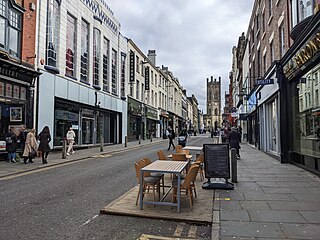
RopeWalks is a district of Liverpool city centre bounded by Hanover Street to the north-west, Lydia Ann Street to the west, Roscoe Street to the east and Back Bold Street to north-east.
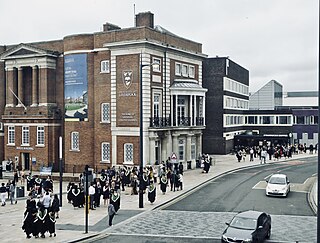
The "Knowledge Quarter" is an area of Liverpool city centre covering 450 acres, incorporating the vicinity around London Road, Islington, the so called 'Fabric District', Paddington Village and part of Canning.

Montpelier is an inner suburban area of Brighton, part of the English city and seaside resort of Brighton and Hove. Developed together with the adjacent Clifton Hill area in the mid-19th century, it forms a high-class, architecturally cohesive residential district with "an exceptionally complete character". Stucco-clad terraced housing and villas predominate, but two of the city's most significant Victorian churches and a landmark hospital building are also in the area, which lies immediately northwest of Brighton city centre and spreads as far as the ancient parish boundary with Hove.
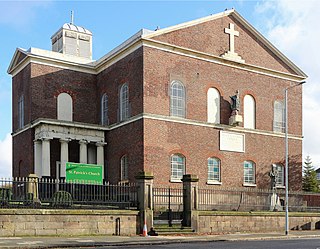
St Patrick's Church is a Roman Catholic parish church in Park Place, Liverpool, Merseyside, England. It is an active parish church in the Archdiocese of Liverpool and the Pastoral Area of Liverpool South. The church is recorded in the National Heritage List for England as a designated Grade II* listed building.

Elm Grove is a mainly residential area of Brighton, part of the English coastal city of Brighton and Hove. The densely populated district lies on a steep hill northeast of the city centre and developed in the second half of the 19th century after the laying out of a major west–east road, also called Elm Grove. Terraced houses, small shops and architecturally impressive public buildings characterise the streetscape: within the area are a major hospital, two churches and a former board school, as well as Brighton's oldest council houses and an interwar council estate.

St. John's Market was a municipal retail market hall in Liverpool, England, housed in a purpose-designed building erected between 1820 and 1822 to a design by John Foster, Junior. It quickly came to be seen as a model for market halls erected elsewhere in the UK in the 19th century. The north and south facades of the building were altered in 1881 and 1891; it was demolished in 1964, making way for the 1969 St Johns Shopping Centre, the western half of which occupies the hall's site.






















